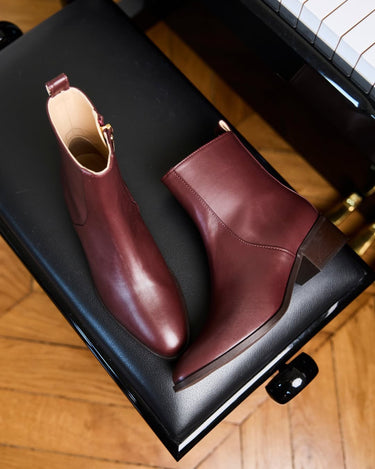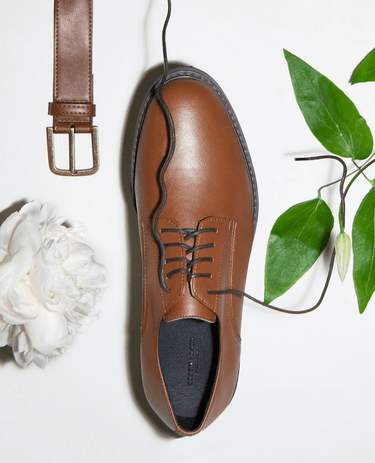The New Frontier Of Sustainable Fashion: Lab-Grown Leather
There was a time – and it wasn't too long ago – when if you liked to wear leather, you had to choose between wearing a dead cow's skin or shiny, squeaky "pleather". As the climate crisis advanced and fashion was forced to reckon with the impact of the extensive leather industry on the planet, innovation brought us a bevy of plant-based leathers to rival traditionally produced animal hides as well as petroleum-derived synthetics. But material development does not end there. Lab-grown leather is the newest step at the cutting edge of innovation.
By Sascha Camilli: writer, speaker, activist, and vegan fashion expert.
In this story, we will look at:
- Why make leather in laboratories?
- How is lab-grown leather made?
- What makes lab-grown leather sustainable?
Why make leather in laboratories?
A variety of products are being developed in laboratories these days: lab-grown meat, lab-grown diamonds are both in the works, and now we're inching closer to producing lab-grown leather. Ground-breaking companies are experimenting with ways to cultivate leather without the use of planet-destroying factory farms which contribute enormously to the climate crisis and kill over a billion animals per year. But instead of relying on petroleum, these companies are attempting to create real leather – only instead of raising an entire cow on a farm, they are devising ways of just growing the skin.
UK-based 3D Bio-Tissues, which works on lab-grown meat products but also produces Lab-Grown Leather Ltd, has created a product that is free from harm to animals but can still be tanned and treated with traditional methods. "Unlike other alternatives that rely on synthetic supports or fillers, LGL’s leather is 100% pure animal tissue, cultivated entirely in a lab. This innovation offers unparalleled quality and consistency, making it superior to anything else on the market," says Dr Che Connon, Managing Director of BSF Enterprise which owns Lab-Grown Leather Ltd.

How is lab-grown leather made?
Often, this will involve taking a biopsy from a living animal, such as the case of VitroLabs. "Cells know just what to do once you give them the right environment," the company says on its website. Their system is all about providing that environment. Through a bioreactor, they stimulate the cells with nutrients and signals to make it grow into a full hide. However, some vegans see issues with lab-grown leather originating from real animal cells, as it is technically still an animal-derived product, despite saving countless lives by relying on a biopsy rather than slaughter.
Lab-Grown Leather Ltd also uses animal biopsies, but without any extra help. "LGL’s lab-grown leather is unique in that it does not use any additional supporting materials, such as plastics or cellulose in the final skin product, says Dr Connon. "The process makes use of a serum-free and animal-free cell culture media supplement, City-mixTM, which accelerates tissue formation whilst reducing the cost of the production process."
But not everyone in the biofabrication space works with animal biopsies. One of the most prominent innovators in this sector is Modern Meadow, a New Jersey-based company founded way back in 2011 – and since then, the development of fashion-ready materials made from tissue cultures has taken big leaps forward. Currently, the company uses Bio-Alloys™ – proteins derived from plant-based ingredients - as a key ingredient in their innovation.
“Bio-Alloys™ [offer] enhanced performance and sustainability at scale as an alternative to leather, but also as a performance fabric in its own category,” Modern Meadow co-founder Andras Forgacs told TED. The company's latest innovation BIO-VERA is crafted with over 90% renewable carbon content and Bio-Alloys™. It will be showcased at the Lineapelle exhibition in Milan, positioning it as a viable alternative to animal skins – one that will not only spare countless animals, but also help stave off the worst impacts of the leather industry on the climate crisis.
What makes lab-grown leather sustainable?
How exactly does lab-grown leather help alleviate the harm leather does to the planet? Eliminating factory farms would cut down pollution massively: greenhouse gas emissions, air and soil pollution, and deforestation would diminish drastically, among other factors. Naturally, factory farms are not only leather-related - the meat industry accounts for the driving force behind them. But leather is a mighty industry, worth over 440 billion dollars. The demand for leather, by industries such as fashion, props up factory farms and worsens the climate crisis.
When it comes to the environmental prowess of lab-developed materials, Dr Connon has no doubt. "We believe that lab-grown leather offers a sustainable and efficient alternative to traditional farm-grown leather production. Traditional methods involve removing non-collagen substances from animal skins or hides, such as hair, fat, and epidermis, and opening up collagen fibres for downstream processes. These initial stages in leather production contribute significantly to environmental pollution and health risks – in addition to animal welfare concerns – accounting for 75% of the oxygen demand, 79% of suspended solids, 100% of sulfide emissions, 85% of nitrogen emissions, and 74% of chloride emissions."

Dr Connon also touches on the harmful tanning process, which is behind some of leather's damaging impact on the planet. “The traditional process may also require hazardous chemicals like sodium sulfide and sodium hydrosulfide. However, by using unique lab-grown methods, these environmentally damaging and hazardous stages are eliminated, significantly reducing the overall ecological footprint of future leather production."
It is difficult to say when we will find bags and shoes made from lab-grown leather in stores. Biotech companies are working on making the products commercial and focusing on scaleability for industries, but as with any ground-breaking innovation, the road there is long and filled with unexpected challenges. However, with the promise lab-grown materials carry, development is accelerating towards a new era of animal-free, tech-powered materials. The future of fashion just may be grown in a laboratory.
By Sascha Camilli
About Sascha
Sascha Camilli is a vegan fashion writer, speaker and activist. Her book Vegan Style is out now on Murdoch Books. For more about Sascha, you can read our interview with her or read her newsletter Kind of Wild. You can also follow her on Instagram, Twitter and LinkedIn.
All images courtesy of 3D BioTissues
For more great content like this in your inbox, sign up to our newsletter, and save 10% off your next purchase, plus great savings throughout the year.
Related Articles

Vegan Christmas Gifts For Him

Vegan Christmas Gifts For Her
















































































































